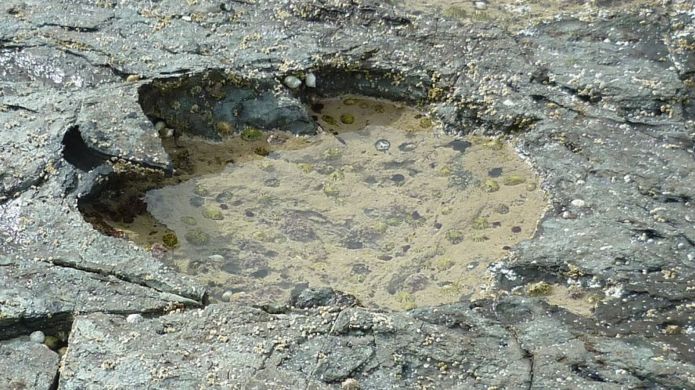
Palaeontologists unearth170-million-year-old tracks of Theropod and Sauropod in Scotland
In an astonishing discovery, researchers have got hold of giant dinosaur prints on the Isle of Sky. As per the reports, the researchers have traced dozens of giant dinosaur footprints that are believed to be around 170 million years old. These newly-discovered dinosaur tracks were made in a muddy lagoon off the north-east coast of the present-day Isle of Sky. The research was carried out Edinburgh University researchers.
The giant prehistoric dinosaur footprints can give important insight into the evolution of the Jurassic era reptiles. The footprints consisted of both theropods and sauropods. Most of the footprints were found to be of theropods, the “older cousins” of Tyrannosaurus rex and rest were of the long-necked sauropods. This is not the first time that dinosaur footprints are discovered on Skye. In 2015, also researchers got hold of a set of ancient dinosaur footprints on the Isle of Skye.
But the latest dinosaur footprints discovery is very important as they were made in older rocks. Lead author of the study, Paige dePolo informed, “It was found in rocks that were slightly older than those previously found at Duntulm on the island and demonstrates the presence of sauropods in this part of the world through a longer timescale than previously known.”
The researchers have described the discovery as “Globally Important” as the footprints were found to be dating from the Middle Jurassic period. And, there are very few fossil sites or dinosaur footprints that are found across the world from the middle Jurassic period. The leader of the field team, Dr. Steve Brusatte, from the University of Edinburgh’s School of GeoSciences, The more we look on the Isle of Skye, the more dinosaur footprints we find.”
Brusatte informed that the new site recorded two different types of dinosaurs, one is the long-necked cousins of Brontosaurus and the other is the sharp-toothed cousins of T. rex, hanging around a shallow lagoon, back when Scotland was much warmer and dinosaurs were starting their march to global dominance. Brusatte and his team photographed, measured and analyzed around 50 dinosaur footprints present on Skye’s Trottenish peninsula. The results revealed that the largest dinosaur footprint of about 70 cm across was of a sauropod. Also, the largest theropod footprint measured about 50cm across. The researchers managed to trace two ancient dinosaur trackways along with many isolated footprints.
Theropods are a dinosaur suborder characterized by hollow bones and three-toed limbs. They are generally classed as a group of saurischian dinosaurs, though a 2017 paper has put them in a proposed clade Ornithoscelida, along with the Ornithischia. Theropods were ancestrally carnivorous, although a number of theropod groups evolved to become herbivores, omnivores, piscivores, and insectivores. Theropods first appeared during the Carnian age of the late Triassic period 231.4 million years ago (Ma) and included the sole large terrestrial carnivores from the Early Jurassic until at least the close of the Cretaceous, about 66 Ma. In the Jurassic, birds evolved from small specialized coelurosaurian theropods, and are today represented by about 10,500 living species.
Sauropods are an infraorder of saurischian (“lizard-hipped”) dinosaurs. They had very long necks, long tails, small heads (relative to the rest of their body), and four thick, pillar-like legs. They are notable for the enormous sizes attained by some species, and the group includes the largest animals to have ever lived on land. Well-known genera include Brachiosaurus, Diplodocus, Apatosaurus and Brontosaurus.
Sauropods first appeared in the late Triassic Period, where they somewhat resembled the closely related (and possibly ancestral) group “Prosauropoda”. By the Late Jurassic (150 million years ago), sauropods had become widespread (especially the diplodocids and brachiosaurids). By the Late Cretaceous, those groups had mainly been replaced by the titanosaurs, which had a near-global distribution. However, as with all other non-avian dinosaurs alive at the time, the titanosaurs died out in the Cretaceous–Paleogene extinction event. Fossilised remains of sauropods have been found on every continent, including Antarctica.
The name Sauropoda was coined by O.C. Marsh in 1878, and is derived from Greek, meaning “lizard foot”. Sauropods are one of the most recognizable groups of dinosaurs, and have become a fixture in popular culture due to their large sizes.
Complete sauropod fossil finds are rare. Many species, especially the largest, are known only from isolated and disarticulated bones. Many near-complete specimens lack heads, tail tips and limbs.


